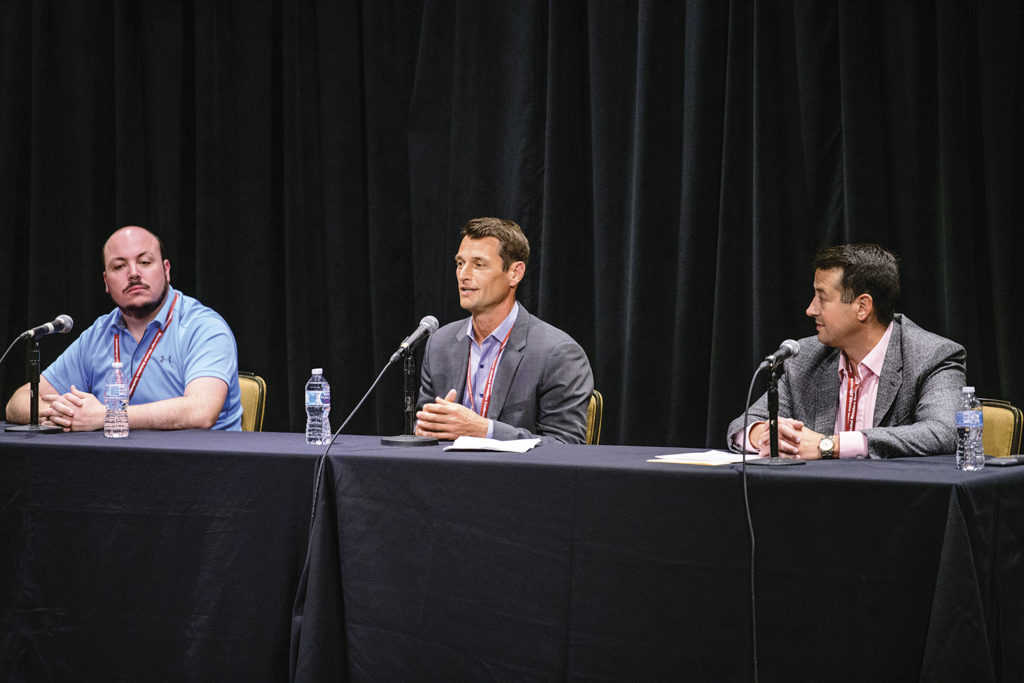Eventually the Covid-19 pandemic will wind down and industries worldwide like alcohol retail will move into a new world.
What will that look like? How will we act once the health crisis finally, mercifully recedes?
For a preview, look to the 2021 Beverage Alcohol Retailers Conference. Our annual event took place this summer in Austin, TX — before the Delta variant fueled another Covid spike
Many parts of this in-person conference felt odd. Handshakes. Indoor gatherings. Masks off. Meetings face-to-face. For most attendees, it was their first large in-person event since Covid slammed into America.
Signs of the health crisis still lingered, of course. Conference meals came in little individual containers rather than spread-out buffet style. Signs onsite and throughout Austin reminded people to wear masks if not vaccinated. And Covid safety procedures in the airports and airplanes continued to feel like 2020.
Otherwise, it was a whole new world.
Alcohol Retail Post-pandemic
One of the primary topics at BARC 2021 was the future of the alcohol industry as the pandemic subsides.
The upshot? It’s difficult to tell.
“We have no precedent for coming out of a once-in-a-generation pandemic,” says Kami Banks Kane, owner of Delaware’s Banks Wine & Spirits and Top 100 winner, as she sat on the Industry Trends Panel.
The last time that America was in this odd, healing, fluid situation was the end of the Spanish Flu in 1920. Suffice to say, the world was different 100 years ago. Drawing parallels between now and then is not so simple.
So what can we predict for the new few years as Covid-19 recedes from our lives? For one, many attendees agreed: not all pandemic trends will continue.
The future of at-home mixology was met with skepticism, for instance. As bars and restaurants continue to reopen and recoup customers, the at-home mixology trend of 2020 will likely shift back to on-premise consumption.
The reopening of America will also affect retail alcohol sales. As dollars flow back to on-premise, retailers will unlikely replicate their extraordinarily high 2020 revenues. But this shift in consumer spending will not occur overnight.
“I think of it like a blown-up balloon,” says Banks, during the trends panel. “It got real big and now the air is gradually coming out, deflating slowly.”

One pandemic trend that nobody thought would decline considerably is ecommerce. Pick your metaphor — the cat’s out of the bag, the genie’s out of the bottle — because they are all true. Consumers who learned that they could order alcohol online during the pandemic, and have it delivered to their home, are not about to forget this new convenience. While not matching the hyper-growth of 2020, ecommerce is here to stay.
So too is one frustration from the pandemic. Namely: shortages. Covid-19 wreaked havoc on the manufacture and wholesale of all manners of raw materials. Complicating the issue, the world is now reopening and rebuilding faster than producers and distributors can keep up. Shipping bottlenecks remain. Demand badly outstrips available supply.
Alcohol feels this pinch with glass and aluminum. A shortage that began in the latter pre-pandemic — caused by the explosion of seltzers and RTDs — worsened significantly during Covid. Glass supply shrunk next. Now, leading American distilleries are considering non-glass bottles for their name-brand whiskeys.
Ask around and nobody has a precise estimate for when these shortages might abate. A common guess, though, is by sometime 2022 — at the earliest. Beyond that, it’s another mystery of our post-Covid era.
One bit of good news? Dan Butkus, VP of sales at Campari, believed that the bourbon shortage would conclude sooner than later. During the Three Tier Panel, he predicted that bourbon stocks would finally catch up with demand in the next several years.
Seeing that so many distilleries have recently invested in expansion — doubling production, in some cases — it’s hard to disagree with this hopeful vision.
Diversity and Inclusivity
Opening keynote speaker TJ Douglas, co-owner of The Urban Grape in Boston, delved into a critical issue facing the alcohol industry — now and in the years ahead. Despite recent advancements, we still have a long way to go in diversity and inclusivity.
Douglas expressed concern that customers may look at him — an individual of color — and not necessarily believe he’s an expert in wine. (A Top 100 winner, Douglas is a leading innovator in wine retail.) This frustration extends to his staff. Too often he sees other individuals of color apply for lower positions, such as stock boy, rather than areas with advanced skillsets.
This is troubling for many reasons. On one hand is the hurtful, insulting inequality prolonged by alcohol categories unconsciously associated with certain colors, classes or genders. This same issue affects women in whiskey. A common but false assumption is that women prefer smoother, lower-proof spirits. Studies (and reality) prove otherwise.
On the other hand, continuing racial and gender biases is simply bad for business. The U.S. population becomes more diverse every year. If you do not reach out and connect with these diverse customers, you will lose out to businesses and brands more in touch with the changing demographics of the country.
To address these issues, Douglas and his wife Hadley, Urban Grape co-owner, recently created the Urban Grape Wine Studies Award for Students of Color. Recipients attend the four-level Certificate Program in Wine Studies at Boston University’s Elizabeth Bishop Wine Resource Center. Recipients also receive hands-on, paid internships in the industry.
The goal is to “reduce racial isolation in the wine field.” Douglas, a graduate of the BU program himself, lamented that he’s too often the only individual of color at industry events. Thanks to his and his wife’s scholarship, diversity in wine is already improving.
Kyle Swartz is editor of Beverage Dynamics magazine. Reach him at kswartz@epgmediallc.com or on Twitter @kswartzz. Read his recent piece 9 Alcohol Trends in 2021-22.




